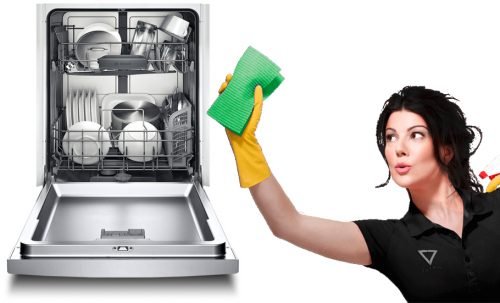
At first, it may seem that dishwashers do not need special care because they look clean for quite a long time. But in fact, with each washing cycle, the operating parts are inevitably contaminated with the residue of hard water, food debris, and detergents. Scale and fat residue gradually lead to breakage or inefficient operation. Therefore, cleaning the dishwasher is the main condition for its long operation.
Let’s find out how to clean the dishwasher in 7 simple steps at home.
Step 1. Washing the Mesh Strainer
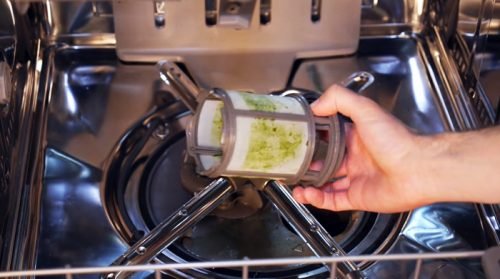
Let’s start with cleaning the mesh strainer, which must be cleaned once a week. After all, fat residue, clogging small cells, which causes an unpleasant smell, and most importantly, leakage, quickly forms in it.
To remove the filter, the lower basket is carefully removed and disassembled. The extracted filter should be rinsed under a stream of water with a usual dishwashing liquid and placed back.
Step 2. Cleaning the Blades
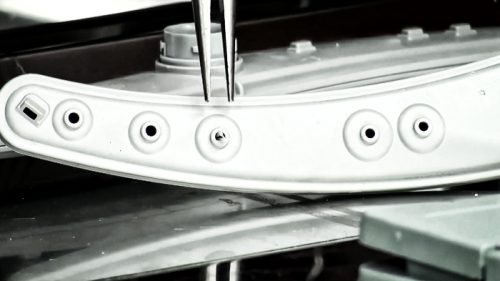
Now we will clean the blades (the impeller or the rockers), which are also cleaned as they get dirty. They can be clogged with the remains of food or scale. If this happens, then all the blades should be removed and washed alternately, and the holes should be cleaned with a toothpick as shown in the next photo.
After assembly they should rotate well if this does not happen, then descaling of the shaft is also needed.
Step 3. Cleaning the Seals
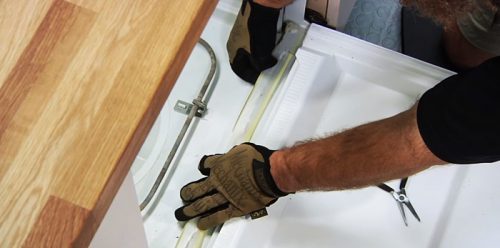
The door sealer should be cleaned every 6 months. A specialized agent, recommended for this purpose by the dishwasher manufacturer, is to be purchased.
- It is convenient to clean the space between the gaskets with a toothbrush.
- It is better not to use folk means like citric acid because the rubber gasket loses its elasticity because of them, which means that the dishwasher may begin to leak.
Step 4. Washing the ‘Dead Zone’ and the Baskets
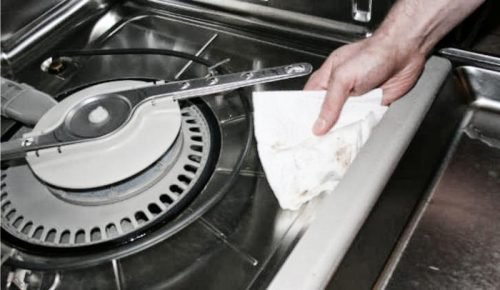
There is a ‘dead zone’ in the lower part of the door of the washer – there is no water coming in, and the debris accumulates. You shouldn’t forget to clean this part thoroughly.
The plastic parts of the basket are cleaned easily and quickly with a brush and dishwashing liquid.
Step 5. Getting Rid of Fat, Mildew, and Rust
Now you need to remove all visible dirt, mildew, fat, and rust:
- You will need to apply bleacher to remove the mildew. However, this process will be dangerous for the parts made of stainless steel, so it is better to prevent the reproduction of fungi, drying the appliance regularly. To do this, simply leave the door open so that the inner compartment is ventilated;
- Removal of rust. Use a special agent to remove rust, but it is also important to understand why corrosion occurs. So, over time paint on the baskets can begin to peel, and then you can update the coating with a special sealant. And in order to prevent water from entering the inside of the device with a significant iron content (from rusty pipes, for example), a filter should be put in at the entrance.
- Theoretically, the tank, the door, the seals and the coarse-mesh filter should be wiped every day.
Step 6. Descaling the Dishwasher
To remove scale, it is best to purchase a special product and run one short washing cycle with it, or vice versa, the most powerful one and run along mode at the maximum temperature – it depends on the selected cleaner. Of course, the dishwasher must be empty.
- Which dishwasher cleaner should be chosen? The most common one is the cleaner from Finish. But there are other effective liquids.
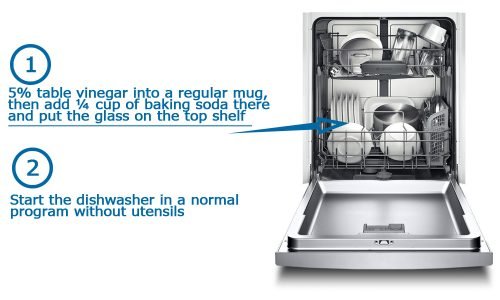
It is not recommended to use citric acid, as it can damage the gaskets. In extreme cases, you can clean the dishwasher with soda and vinegar: pour 5% table vinegar (if you dissolve it from the 70% essence, then you need to add 13 tablespoons water to 1 tablespoon of the essence) into a regular mug, then add ¼ cup of baking soda there and put the glass on the top shelf (for mugs). And then start the dishwasher in a normal program without utensils.- This cleaning should be carried out once every 3 months.
The most important advice is that you shouldn’t disregard the regular use of salt for the prevention of scale because it changes the composition of water and does not allow the accumulation of sediments.
Step 7. Wipe the Dishwasher Clean
After the end of the cycle, just wipe the dishwasher tank – if any dirt remains, it should be easily eliminated.
Well, that’s all; your assistant is ready for normal work again!
